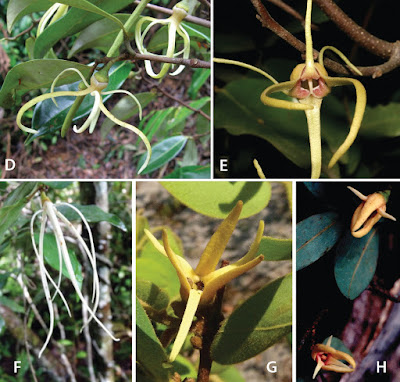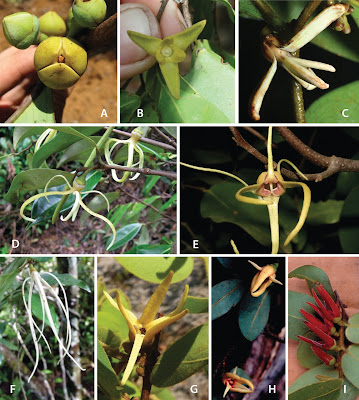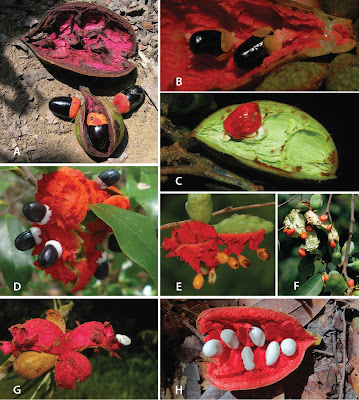 |
| Peritresius martini Gentry, Parham, Ehret & Ebersole, 2018 |
Abstract
Late Cretaceous members of Peritresius belong to a diverse clade of marine adapted turtles currently thought to be some of the earliest representatives of the lineage leading to modern hard-shelled sea turtles (Pan-Cheloniidae). Prior studies have suggested that Peritresius was monospecific, with a distribution restricted to Maastrichtian deposits in North America. However, new Peritresius specimens identified from Alabama and Mississippi, USA, show that the genus contains two taxa, Peritresius ornatus, and a new species Peritresius martini sp. nov. These two taxa are characterized by the presence of a generally cordiform carapace with moderately serrated peripherals, well-developed ventral flanges beginning at the third peripheral, squarish umbilical and lateral plastral fontanelles, and a narrow bridge formed by the contact between the hyoplastron and hypoplastron. Peritresius martini sp. nov. can be distinguished by its lack of dermal ornamentation and the presence of a ‘rib-free’ 10th peripheral. These new specimens represent the first occurrences of Peritresius from the Late Cretaceous Mississippi Embayment and extend the temporal range of this genus back to the early Campanian. When tested within a global phylogenetic context, Peritresius is placed on the stem of Cheloniidae (Pan-Cheloniidae) along with Ctenochelys and Allopleuron hofmanni. The heavily vascularized and uniquely sculptured dermal elements of P. ornatus are interpreted here as potentially relating to thermoregulation and therefore may have been one of the key factors contributing to the survival of Peritresius into the Maastrichtian, a period of cooling when other lineages of Campanian marine turtles (e.g., Protostegids, Toxochelys, and Ctenochelys) went extinct.
Systematic Paleontology
Reptilia Laurenti, 1768
Testudines Batsch, 1788
Cryptodira Cope, 1868
Chelonioidea Baur, 1893
Pan-Cheloniidae Joyce, Parham, and Gauthier, 2004
Genus Peritresius Leidy, 1856
Type species: Peritresius ornatus Baird, 1964, figs 1–8, Navesink Formation (upper Maastrichtian), Burlington County, New Jersey, USA.
Amended diagnosis: Cretaceous pan-cheloniid differentiated from Allopleuron hofmanni in having a more broadly rounded carapace, a decreased distance between the axillary and inguinal notches of the plastron, a lack of elongate, finger-like lateral projections of the hypoplastron, and the relatively constant width of peripheral elements 3–11. Differentiated from pan-cheloniids such as Ctenochelys by a greatly expanded contact between the left and right epiplastra, significantly reduced contact between the hyo- and hypoplastron due to the presence of large central and lateral plastral fontanelles, and a highly domed carapace as evidenced by the broad angle (90°-120°) formed by the dorsal and ventral facets of peripherals 3–8. Specimens can be diagnosed as Peritresius by the following combination of features: generally cordiform carapace having peripheral elements with moderate lateral serrations; a single mid-sagittal keel on the dorsal surface of the carapace (ch.116/3) consisting of 7 keeled neurals (ch.126/1) with epineural ossifications situated at the junctures of neurals 3–4, 5–6, and 7-suprapygal 1; reduction in peripheral height moving posteriorly from peripheral 4; ratio between the axillary-inguinal distance of the plastron and the length of hyo-hypoplastral contact >2.5:1 (plastral index is this value * 100); and thyroid fenestra subdivided by pronounced contact between the pubes and ischia (ch.224/1).
Peritresius martini sp. nov.
Etymology: martini: for the discoverer and initial preparator of the holotype specimen, Mr. George Martin of Auburn, Alabama.
Differential diagnosis: As for genus but can be distinguished from Peritresius ornatus by a lack of sculpturing on the dermal surfaces of the carapacial elements, a less pronounced lateral keel of the anterior peripherals, and a ‘rib-free’ 10th peripheral (ch.133/2).
Holotype: ALMNH 6191 (Figs 3–5), includes peripherals 3–6 and 8–11 of the right side, peripherals 8–11 of the left side, pygal, partial 1st suprapygal, right epiplastron, right hyoplastron, both hypoplastra, both xiphiplastra, and an articulated pelvic girdle.
Type locality: Site ALn-8, Dry Cedar Creek, Lowndes County, Alabama, USA.
Type stratum: Lower Ripley Formation, lower Globotruncana aegyptiaca Interval Zone, upper Campanian.
....
Remarks:
A confluent thyroid fenestra has been suggested as a derived characteristic of crown cheloniids based on the subdivided thyroid fenestra of many early cryptodires and the absence of such a division in fossil chelonioids like Toxochelys latiremis and Lophochelys spp. Zangerl 1953 [2] ([49]). However, the presence of a divided thyroid fenestra in Peritresius spp., A. hofmanni, and certain extant cheloniids such as Caretta caretta may indicate this feature was lost early in pan-chelonioid evolution and later reacquired in select lineages of pan-cheloniids. It is also possible that Late Cretaceous sea turtles, such as Toxochelys and Peritresius, represent distinct radiations of marine adapted turtle potentially due to multiple invasions of marine environments by Testudines during the latter half of the Cretaceous, with the plesiomorphic condition retained in one lineage (Peritresius) and lost in another (Toxochelys). Testing the latter scenario using only morphology based phylogenetics would require an extensive review of the pelvic elements of fossil and extant Testudines in order to ensure that any character set or coding strategy regarding the arrangement of these elements was sufficiently inclusive to provide meaningful resolution between members of clades containing highly convergent lineages (i.e. marine turtles). Such a review is beyond the scope of the present study but is certainly an area of chelonioid evolution in need of further examination.
Peritresius ornatus Leidy, 1856
Chelone ornata Leidy [1856]: 105, pl. 18, fig 10.
Peribresius [sic, errore] ornatus. Cope in Cook [1869]: 735.
Peritresius ornatus Cope [1869]: 88; 1870: 150.
Prochonias nodosus Cope [1870]: 158, 159.
Taphrosphys nodosus Cope [1870]: 167, 244, pl. 1, fig 16.
Peritresius ornatus = ? Taphrosphys nodosus Hay [1908]: 122, 210.
Peritresias [sic] ornatus Miller [1955]: 908.
Peritresius ornatus Baird [1964]
| Fig 9. Time-calibrated, strict consensus phylogeny of select fossil and extant Testudine species. |
Conclusions:
A new species of Cretaceous marine turtle from the southeastern United States (Peritresius martini sp. nov.) is herein described based on material collected from the upper Campanian of Alabama, USA. Peritresius martini sp. nov. differs from Peritresius ornatus in having a ‘rib-free’ 10th peripheral, a less pronounced lateral keel on the anterior peripherals, and an unsculptured carapace and plastron. The heavily vascularized and sculptured dermal elements characteristic of P. ornatus are interpreted here as potentially indicative of a thermoregulatory capability and may have been one of the key factors contributing to the survival of Peritresius into the Maastrichtian, a period of cooling when other lineages of Campanian marine turtles (e.g., Protostegids, Toxochelys, and Ctenochelys) went extinct.
Andrew D. Gentry , James F. Parham, Dana J. Ehret and Jun A. Ebersole. 2018. A New Species of Peritresius Leidy, 1856 (Testudines: Pan-Cheloniidae) from the Late Cretaceous (Campanian) of Alabama, USA, and the Occurrence of the Genus within the Mississippi Embayment of North America. PLoS ONE. 13(4): e0195651. DOI: 10.1371/journal.pone.0195651














































































